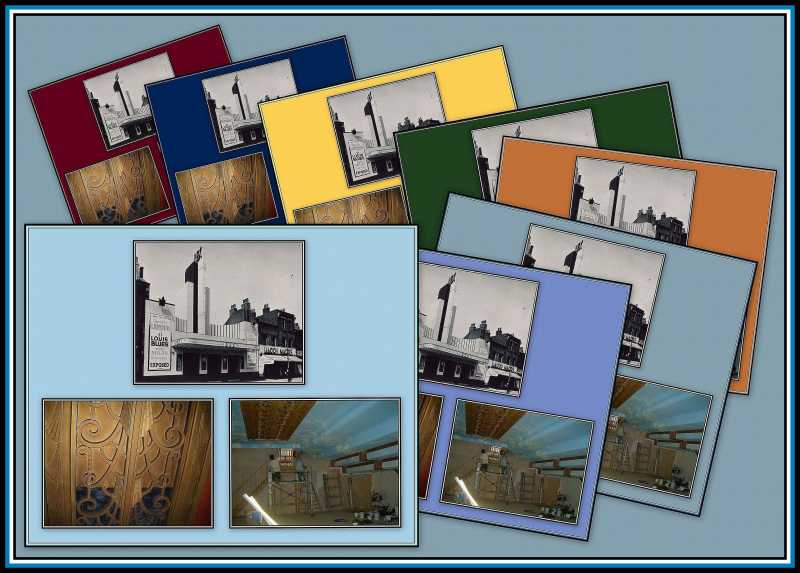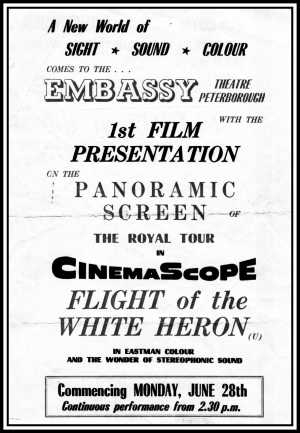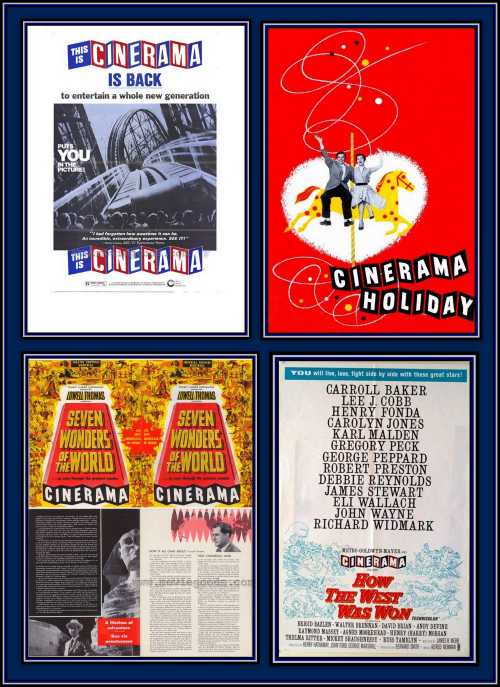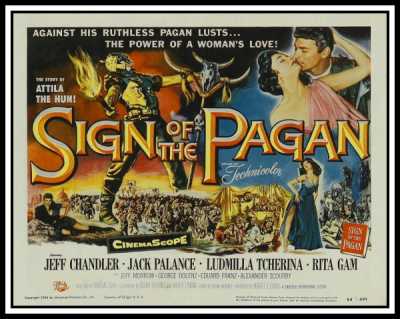| Mr
HARVEY FRANKLE of FRANKLE
TRIMMINGS wrote: This
was a very interesting
read and you have added
some most kind comments
about my company.
When
redecorating the front of
the building, we referred
to old photos and tried
to recapture the elegance
of the cinema as it was
in 1939. We have also
kept the Art Deco
influence inside and
added a Vegas-style
sky.

BRIAN
HALL wrote:
REFLECTIONS
ON CINEMASCOPE AND OTHER
CINEMATIC PROCESSES
When I was
in my early teens I was
completely absorbed by
films and cinema. My
parents had taken me
regularly, once or twice
a week, since I was about
seven years old. When I
was about thirteen years
old, I made the momentous
decision to give up my
weekly comic (I think it
was the Eagle at
this time) and take a
film magazine. The first
one I bought was Picture
Show. Later, I would
change this and take Picturegoer
because it had longer
articles in it. In 1952,
the big buzz in
cinema was all about the
new screen processes.
Although I saw Metroscopix,
a hang over from the
thirties, since none of
the Peterborough cinemas
were adapted for the new
polaroid 3-D, it
seemed unlikely that I
was going to have an
opportunity to experience
a film made in this
process. However we went
on holiday to Scarborough
and the Aberdeen Cinema
in Aberdeen Walk was
showing a film in 3-D
- I was there! The special
glasses cost an
additional 6d and while
waiting to buy my ticket,
I listened to a poor lad,
who had only been given
enough money to get in, plead
with the attendant to let
him have the glasses. OF
course he refused!
However, the boy,
obviously a real fan,
said he would go in
anyway. The attendant
told him he would be
wasting his money, as the
picture would be blurred.
I never discovered what
happened in the end
because I was too eager
to get inside and see the
film. The first film I
saw in 3-D was Hondo
with John Wayne. I was
not disappointed by the
process and was thrilled
by the flaming arrows
that seemed to be shot at
me from the screen! The
next week, the cinema
showed a southern romance
set in the Everglades and
starred Rhonda Fleming in
a crinoline and the likes
of Fernando Lamas or
Ricardo Montalban as her
leading man. I have long
since forgotten the title
of this film.
The next
big screen event to be
presented for public
entertainment was three
screen Cinerama
process. Regrettably, I
never saw it until
several years later, as
it could only be shown in
specially adapted cinemas
and we had no such cinema
in Peterborough! But my
magazine then informed me
about another new
cinematic process called
CinemaScope, which was
being advertised as the
Miracle You See Without
Glasses. 20th
Century-Fox had developed
it and it was far more cinema-friendly
than Cinerama.
The first
film produced in CinemaScope
was The Robe,
which opened in London, I
believe at the Odeon,
Leicester Square. As
I lived in Peterborough,
which fortunately is on
the mainline into Kings
Cross Station, I
persuaded my parents to
let me go up to London
along with my friend
Michael to see The
Robe which had by
then been transferred to
the Carlton in the
Haymarket. Apparently Fox
had taken over the lease
of this cinema, as a showcase
cinema for their CinemaScope
Presentations. As a
result of the success of
these films, soon after Fox
also leased the Rialto
cinema in Coventry Street
to be a second showcase
cinema. Michael and I had
to go to a matinee in the
school holidays because
we weren't allowed to
stay into the evening and
were given dire warnings
about talking to strange
men.
And so,
after our train journey,
followed by a ride on the
Underground, we
arrived at the Carlton.
We stumped up what was an
extraordinary
amount compared to
Peterborough prices in
order to get in. Lasting
memory recalls a few
details of our visit. I
remember that we were
impressed by the posh
outfits of the male
ushers as well as the
thickness of the carpet
that our feet seemed to
disappear into. But what
I recall most was the
excitement that we felt
as we sat in those plush
seats and waited for the
house lights to dim and
for the film to start!
Once the lights dimmed,
we were treated to a
short introductory film
on a standard size screen
explaining the wonder
of CinemaScope, which
was followed by an
announcement of the first
film in the process. But
it wasn't The Robe.
Instead we were treated
to a short musical film
in Cinemascope and
stereophonic sound
featuring the Roger
Simeon chorale.
And then
at long last, the cinema
was silenced as the
feature film was
announced! Suddenly, red
plush curtains appeared
on the screen, which then
began to slowly open and
reveal the title
of the film ….. The
Robe! The usual Fox
fanfare and Searchlights
did not accompany this breathtaking
moment! Instead, a
heavenly choir sang
to set the mood and did
so perfectly. My most
vivid memory of the stereophonic
sound was during the
crucifixion when lighting
struck to a terrific
crack of thunder around
me, which continued to
roll throughout the whole
auditorium. Wonderful!
By this
time, I believe that J.
Arthur Rank Company
had fallen out with 20th
Century Fox over the
installation of
four-track sound. Rank
had been installing it in
their more prestigious
cinemas in Birmingham,
Manchester etc, but was
not prepared to do it in
all of the small town
cinemas it ran at that
time. So Peterborough
would not get CinemaScope.
Little did I know that a
group of independent
cinema owners together
with the Granada and
Essoldo circuits had
decided to form a fourth
cinema circuit and
install the required four
track stereophonic
sound system in order
to show Fox’s
CinemaScope Productions. Fortunately
for Peterborough, and me
in particular, the owner
of the town's theatre,
the Embassy,
decided to give up on
weekly variety and join
the newly formed fourth
cinema circuit.
Apparently the owner kept
his future plans quiet
because he did not want
the orchestra members to
know that their days were
numbered until the last
minute in case they left
early and he would be
left without an orchestra
for his last few stage
shows. It seems that he
told the orchestra that
he was closing for week
or two for refurbishing,
and then on the last
night, he gave them their
cards. A true
business man!
 It
came as a complete
surprise to me when I
read the announcement in
the local newspaper that
the Embassy was to
show films on a giant
curved screen from the
following Monday. The
first film shown was not The
Robe, but The
Flight of the White Heron,
Movietone's
CinemaScope account
of the Royal Tour of
Australia, which had been
produced as a full-length
feature film. And so on
that Monday morning, I
took some sandwiches to
school and went straight
to the Embassy for
the tea-time showing. The
Embassy stage was
just the right shape for
a widescreen, but I was
disappointed with the
dull screen curtains that
had been erected.
Although my old friends,
Roger Simeon and his
chorale, were there, I
was now told that Flight...
was the first film in CinemaScope!
I don't know if you could
pin me to my seat today
to watch over an hour and
a half of royal
handshakes, but it
transfixed me then! I
often thought the manager
had made a wise decision
to show this film as his
first CinemaScope
Production, as the
public would probably
have stomached anything
to see the new wonder,
but not after they were
used to the process. One
thing we noticed was that
every other reel seemed
slightly out of focus,
something that was
corrected after a week or
two. The film was well
received and ran for two
weeks. Following this, The
Robe was screened and
also remained at the Embassy
for two weeks. It
came as a complete
surprise to me when I
read the announcement in
the local newspaper that
the Embassy was to
show films on a giant
curved screen from the
following Monday. The
first film shown was not The
Robe, but The
Flight of the White Heron,
Movietone's
CinemaScope account
of the Royal Tour of
Australia, which had been
produced as a full-length
feature film. And so on
that Monday morning, I
took some sandwiches to
school and went straight
to the Embassy for
the tea-time showing. The
Embassy stage was
just the right shape for
a widescreen, but I was
disappointed with the
dull screen curtains that
had been erected.
Although my old friends,
Roger Simeon and his
chorale, were there, I
was now told that Flight...
was the first film in CinemaScope!
I don't know if you could
pin me to my seat today
to watch over an hour and
a half of royal
handshakes, but it
transfixed me then! I
often thought the manager
had made a wise decision
to show this film as his
first CinemaScope
Production, as the
public would probably
have stomached anything
to see the new wonder,
but not after they were
used to the process. One
thing we noticed was that
every other reel seemed
slightly out of focus,
something that was
corrected after a week or
two. The film was well
received and ran for two
weeks. Following this, The
Robe was screened and
also remained at the Embassy
for two weeks.
At about
this time, the Odeon
had a new screen
installed. Gone now were
the old screen tabs with
their strange tree
design. Due to the
increased width of the
new wide screen, it had
to be installed almost
directly behind the stage
curtains. Although the Odeon
could not show Fox
films, other film
companies had adopted CinemaScope
and began to produce
their films in the
process. I remember the Odeon
announced that it would
be showing Sign of the
Pagan with Jeff
Chandler and Jack Palance
that Universal-International
had made and produced
in CinemaScope. I
was hard up that week but
managed to cobble
together the shilling to
sit in the front stalls.
Funnily enough here again
every other reel (i.e.
one of the projectors)
was out of focus and it
seemed so much more
obvious sitting close up
to the screen. I
understood from a friend
who visited the
projection box that
nothing could done to
rectify this until an
engineer came.
Together
with the Odeon, there
was the Broadway
Cinema or Kinema
as it had once been
called. This was a Gaumont
Theatre and was
interesting for its a
very square proscenium.
When it announced the
showing of James Stewart
in The Man from
Laramie in CinemaScope,
I rushed along to see
what changes had been
made to the cinema. When
I got there, I noticed
that little had changed
and that the same square
proscenium was present.
Once the News and Trailers
were shown, the curtains
closed and then reopened
for the main feature.
What soon became apparent
was that the management
had blocked off the top
half of the screen with
black masking leaving a tiny
letterbox screen where
James Stewart appeared!!!
I should have asked for
my money back, but of
course I became too
interested in the film,
although this time, I
wish I had paid to sit in
the front stalls! Later a
new screen was erected in
front of the proscenium
with newly installed festoon
curtains.
Soon after
the introduction of CinemaScope,
other cinematic
processes were developed
including Technirama,
WarnerScope, SuperScope and
eventually Panavision,
which eventually became
the norm in film
production. These were
indeed exciting times for
a teenager!!!
TERRY
GUNTRIP wrote:
MY
CINERAMA MEMORIES
I
can remember that my
grandmother took my
brother and I to see the
first Cinerama
production, 'This is
Cinerama' in the
West End of London in
1953. I was particularly
interested in noticing
that there were three
separate projector beams
coming from the
projection box. One for
the centre of the screen
and another for each
extremity. They were
obviously syncronised to
produce the overall
effect of a very wide
screen picture.
My
only memory of that film
was the roller
coaster ride which
was spectacular and very
realistic. You could
actually imagine that you
were on a real roller
coaster including the G-force
effect (although
this must have been
imaginary!). The film was
basically produced to
show what could be done
using the Cinerama
process.
We
also were taken to see
the second Cinerama
production called 'Cinerama
Holiday' in 1955,
which at least had some
sort of a plot to the
story. This film was
again based around exciting
and colourful outdoor
action incidents and
grand scenic spectacles.
Only this time the
material was strung on a
wisp of story line, which
had the incidents and
spectacles encountered as
the experiences of two
sightseeing couples, one
travelling in the USA and
the other travelling in
Switzerland and France.
The oustanding memory of
this production, for me,
was the trip on a bobsled
down the icy track of the
Cresta Run at
very high speed.
Later,
I was also taken by my
grandmother to see 'How
The West Was Won' but
being a bit young at the
time didn't really
appreciate it but just
wondered how long it was
going on for? It seemed
to be an interminably
long film to me. I have
seen it since on TV but,
of course, you don't get
the widescreen effect.
However, being of more
mature years, I enjoyed
the film much more than I
had done before.

ROB
HUMPHREYS wrote:
BLINKING!
I
loved those old sword
and sandal movies
and still do to this very
day. I remember The
Robe. However,
my favourite was The
Sign Of The Pagan
with Jack Palance.
I remember him playing
Attila the Hun. It
seems funny that we used
to go in halfway through
a showing and see
the endings and then sit
right through and
see them
again! It
always took a few minutes
to be certain when the
bit that was playing
when you came in turned
up again! I
remember how difficult it
was for your eyes to
get used to daylight once
you came out. We
always walked up the
street blinking until
we became accustomed to
the light once more!

PETER
THURGOOD wrote:
GOING
TO THE REX
The story
brought back some fond
memories to me. When I
was a child and my
parents took me to the pictures,
which I suppose was
approximately once a
week, we nearly always
had to queue up behind
boards outside, which
proclaimed which price
seat you wanted. The commissionaire
would come out from time
to time and say, ‘two
seats in the one and
nine's’ or in
the two and
three's.’ So if
there were three of us,
as in our case, we had to
wait until that number of
seats became available.
From time to time, standing
room became
available. In most
cinemas this was at the
back of the auditorium,
where you would look over
the backboard, behind the
last row of seats. The Rex
however, was different,
as the standing room ran
the length of the
auditorium, against a
wall. Whenever somebody
left, an usherette would
shine their torch, and
say ‘one seat in the
one and nine's
anyone?’
In
general, we never got
seats together. It was
only on rare occasions
that we actually got into
the cinema to see the
start of the film. In
those days, we would go
in at whatever time they
allowed us to, even if
the film had only half an
hour to run. This meant
knowing the end
before we had seen the
beginning, hence the
saying, ‘Isn't
this where we came in?’
ANTHONY
BRADLEY wrote:
I had a
good read of your
site. It
is really wonderful
and informative with a
lovely personal
touch. I prefer the
Empress as of
old. I like
the many pictures of the
old buildings that were
cinemas and theatres,
eventually bingo halls
etc. Where I lived
we had a wonderful old art
deco style cinema
called the RITZ,
and I think the doorman
was the brother of Victor
McLaglen (The Quiet
Man) This lovely
cinema ended up as a
bingo hall and lost its
glory. I did find a
lovely old cinema/theatre
in Monmouth some while
ago. Took me right back.
|